Kevin Clarke
Operetta Research Center
21 April, 2018
There is a Facebook group out there called Adonises of the Silver Screen. It offers amazing photos of and anecdotes about legendary actors, often shown in striking half-nude poses. Recently, one of our all-time favorite operetta stars popped up amidst all the Ramon Navarros, Robert Montgomerys, John Gavins and Tab Hunters (we could go on). That operetta star was none other than Adolf Wohlbrück, who is most remembered, in the musical theater realm, for his roles in Der Zigeunerbaron and the Fledermaus adaptation Oh Rosalinda! These Strauss titles might be the direct result of Wohlbrück playing Johann Strauss in the 1933 Walzerkrieg, directed by Ludwig Berger. He was cast opposite another operetta heartthrob in that movie: Willy Fritsch as percussionist in the Joseph Lanners orchestra; Lanner himself being played by Paul Hörbiger.
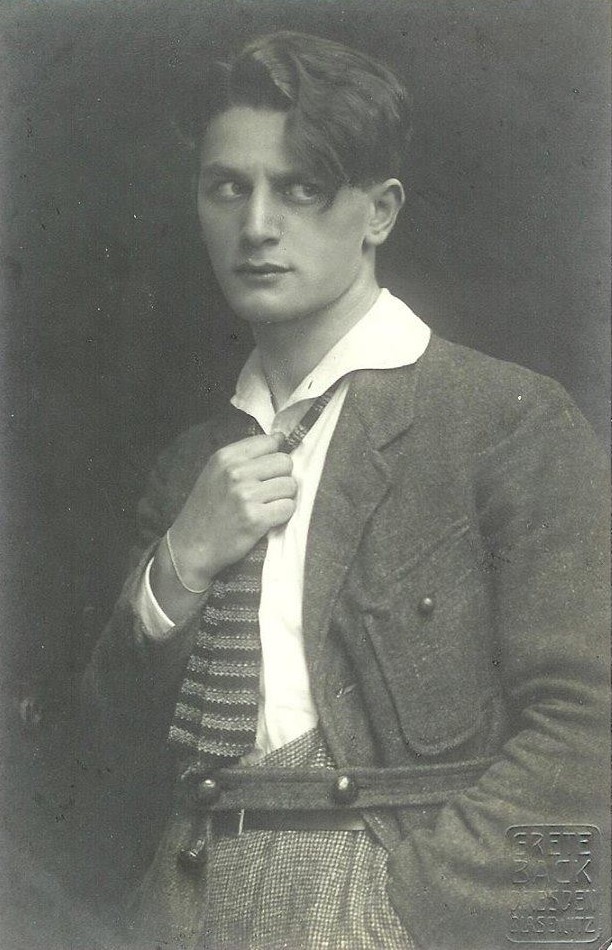
Photo of the young Adolf Wohlbrück, posted on “Adonises of the Silver Screen.”
Wohlbrück isn’t remembered for his singing, but for his striking good looks, cheeky mustache, and suave acting. Combined, they made him an ideal leading man in operettas, because he was able to play his roles with a constant wink in his eyes. He can be heard singing, though, in the Korngold adaptation of Leo Fall’s Die geschiedene Frau, next to Lucie Mannheim, with “Man steigt nach” (“nachsteigen” means: to follow someone with the aim of seducing them). You hear a perfect operetta parlando, and some wonderfully subtle ‘queer’ innuendoes from Mr. Wohlbrück.
Such queer qualities made him ideal for films like Viktor und Viktoria in 1933. A year later he was in Oscar Straus’ Eine Frau, die weiß, was sie will. (No, without Fritzi Massary.) And another year later, there’s Zigeunerbaron with Wohlbrück as Sandor Barinkay. It’s a film version with little Strauss music, but a version that proves that operetta stories can make fully worthwhile movies. Because it’s not just about the music, but the plots too. Something which modern producers tend to forget regularly.
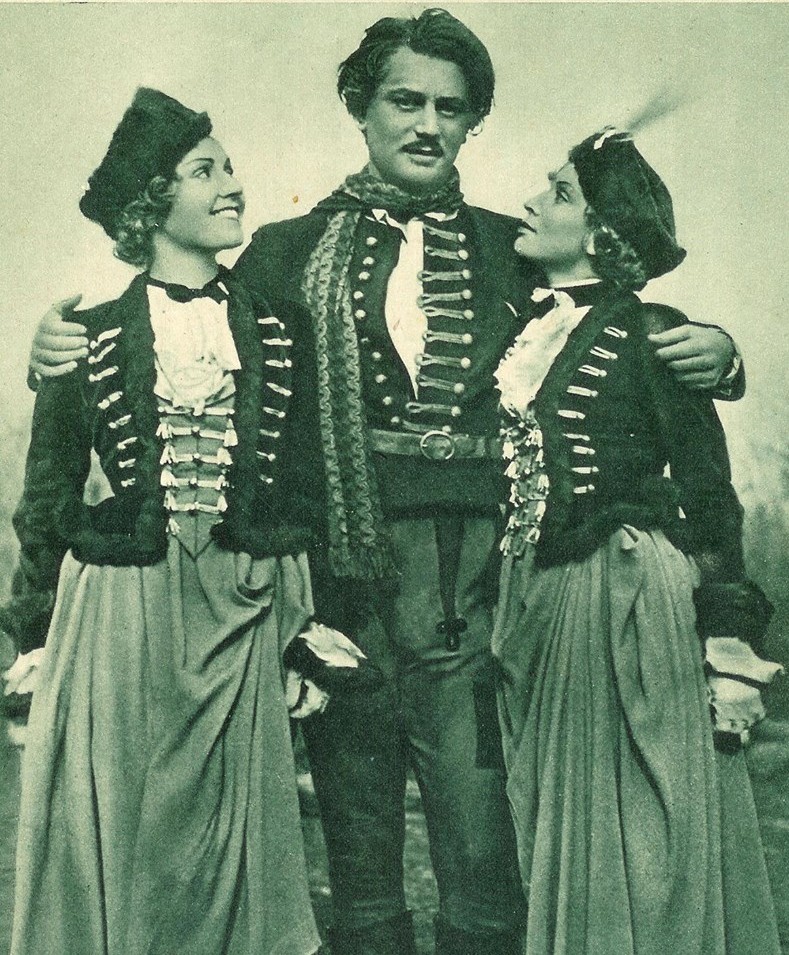
Adolf Wohlbrück as Sandor Barinkay with Arsena from the two different versions of the film: left, French Daniela Parolo, and right, German Gina Falckenberg. (Photo: from “Filmwelt” #46, 1934)
Because of Nazi politics, Jewish and homosexual Wohlbrück left Germany and Austria and went to England (via the USA). In the UK he played a role originated by another operetta superstar, Ivor Novello, in the remake of the movie The Rat in 1937. Many more films followed, one of the most famous is The Red Shoes in 1948, and then there’s the equally famous La Ronde/Der Reigen (1950) with a memorable score by Oscar Straus. The composer made his post-war comeback with the sweeping carousel waltz. And Wohlbrück can be heard, again, with a perfect operetta parlando.
The 1955 Fledermaus version entitled Oh Rosalinda! is in a class of its own, as far as a film adaptations of this particular Strauss operetta are concerned. Because director/producer Michael Powell and Emeric Pressburger didn’t just update the story, they saw to it that their update to the post-war years of Vienna under Russian occupation worked down to the very last detail. It’s a hilarious overall operetta film, starring Wohlbrück as black-market dealer Dr. Falke opposite Michael Redgrave as Eisenstein, and Anneliese Rothenberger as Adele. They are all outstanding, as is Ludmilla Tcherina as Rosalinda.

Poster for the 1955 “Fledermaus” adaptation “Oh Rosalinda!”
Very strangely this film has not been released in a restored version of DVD; it deserves wider circulation as a role model for how the kinky original operetta ideals (and Strauss ideals) were still alive and kicking in the early 1950s, before a post-war moral climate substituted them with a performance tradition that sadly murdered many of the fundamental joys of operetta.
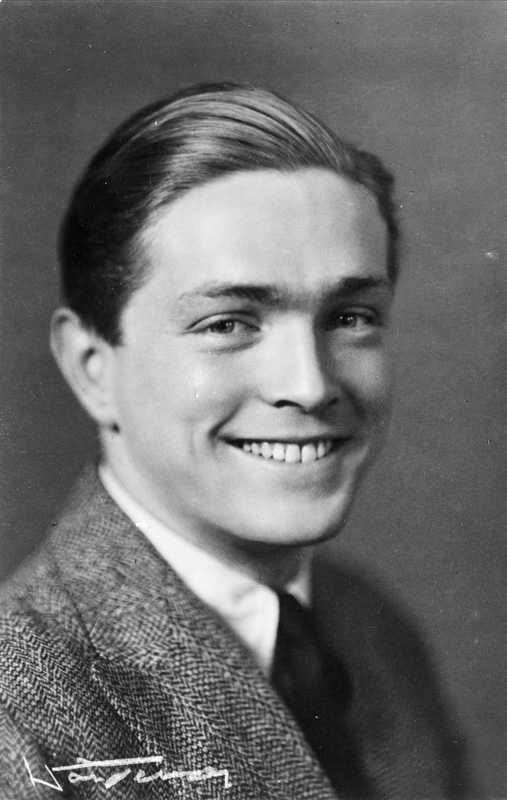
Norwegian painter Ferdinand Finne (1910-1999), photographed in 1935.
When Wohlbrück was discussed in the Adonises of the Silver Screen group, various interesting facts came up. For example that there is a Wohlbrück entry in Mann für Mann: Biographisches Lexikon zur Geschichte von Freundesliebe und mannmännlicher Sexualität im deutschen Sprachraum. There, we learn of his long-term relationship with Norwegian painter Ferdinand Finne, between 1938 and 1946. Apparently Finne left Wohlbröck because the film star started an affair with an 18 year old boy and wanted to persuade Finne to have a ménage a trois. Which didn’t work out, but didn’t stop Wohlbrück from visiting Finne in Norway twice in 1948 and 1949. He also had a relationship with a man named Frederick ‘Foff’ LeGrand.
In 1951 gay theater and movie (and operetta) star, Gustaf Gründgens, persuaded Wohlbrück to appear in Germany again. He did so: in the theater, on TV, and in movies. His career lasted until he collapsed on stage during a performance in Munich in 1967.
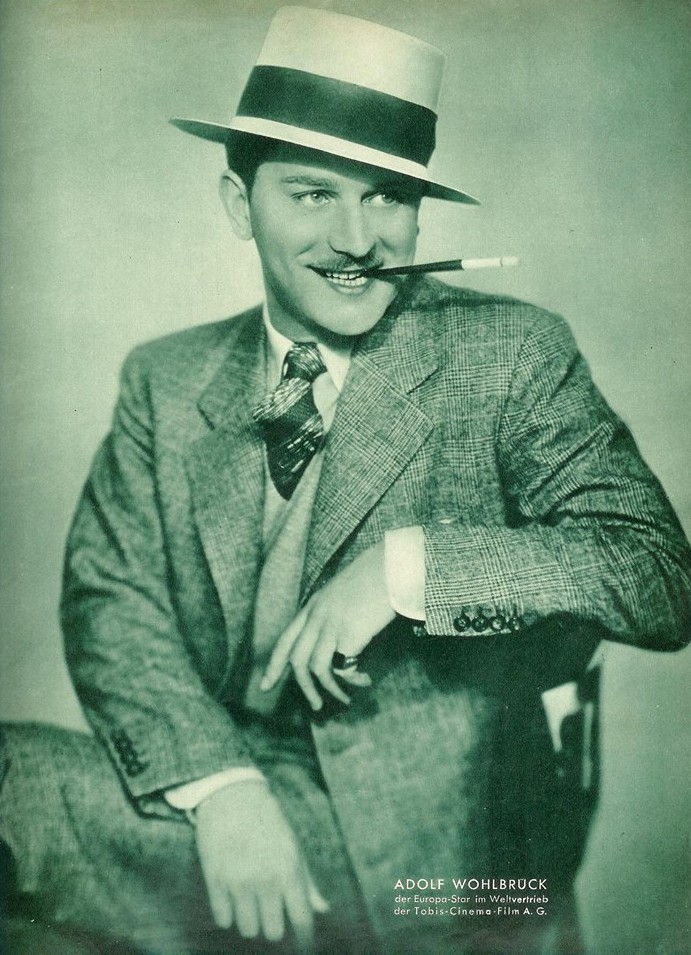
A typical promotion photo of Adolf Wohlbrück – the “European star/Europa-Star” – issued by Tobis-Cinema-Film AG from the early 1930s.
Because homosexuality was still criminalized in England and German until 1967 and 1969 respectively, Wohlbrück had to keep all evidence of his sexual orientation secret. He was officially “a man very quiet about his personal life,” as so many others were too, e.g. Erik Charell of White Horse Inn and Congress Dances fame. Which makes it difficult to write biographies of such people. Apparently, James Downs is trying to do so right now. The question is how the privacy of a person like Wohlbrück should be respected, and how much about a public persona like him can be revealed today – even if it’s by necessity often based on rumors?
James Downs curated an exhibition on Adolf Wohlbrück at the University of Exeter in 2013, entitled Star and Enigma (“Double life of mysterious film star revealed in exhibition”).
The exhibition mentioned that in accordance with Wohlbrück’s wishes, his body was returned to England after his death. “Anton Walbrook,” as he called himself in England, was buried near his home in Hampstead. One knowledgeable commentator in the Adonises chat said “I also read that his grave includes the ashes of his devoted secretary for 23 years, Eugene Edwards, whom he bequeathed his estate, but I don’t know the nature of their relationship.”
Another interesting statement is: “I remember that Powell thought Anton and Michael Redgrave were having an affair during the set of Oh Rosalinda! And also that Michael Redgrave and Anton had ‘Foff’ Legrand in common, though it was a serious relationship for Anton and a fling for Michael! I don’t know if there’s a bio of Michael which evokes his affairs.”
Obviously, my operetta antennas are abuzz when they hear such stories. And I truly hope Mr. Downs’ biography will come out soon with more details.

Michael Redgrave (r.) and Adolf Wohlbrück in “Oh Rosaldinda!” 1955. (Screenshot)
Until about 2010, many cinephiles ignored the fact that Wohlbrück was gay. Just like many operetta fans ignored the fact that Erik Charell was gay, never asking how that affected his productions and how it might make us aware of a second layer of meanings in so many over-familiar shows. It can also make us understand why Charell chose to work with certain actors like Claire Waldoff and Wilhelm Bendow, or Marlene Dietrich. They each gave special LGBT meaning to scenes.
Like Charell, Adolf Wohlbrück/Anton Walbrook seems to have frequented gay bars in Berlin in the 1920s and early 1930s, e.g. the notorious Kleist Casino. Apparently, Wohlbrück was a regular client before the bar’s closing by the Nazi regime in 1933. The actor Harry Pauly was warned by friends to be beware of “the famous gay actor W.” who was notorious for chatting up men. Pauly claims that Wohlbrück made “keen ovations” to him, but never touched him. At least that’s the (semi-)official version.
As it turns out, there is also a fan page dedicated to Adolf Wohlbrück/Anton Walbrook on Facebook. It has 304 members and is a “closed group” – you have to apply and answer questions to get in. To discuss more freely behind closed curtains?

Anton Wohlbrück, topless, in “Der Kurier des Zaren,” an adaptation of Michael Strogoff. A photo on display at the Schwules Museum in Berlin.
Needless to say, my interest is aroused. It’s always worth re-watching all these historic operetta related movies by Wohlbrück and remember stars like him who brought something to operetta that has been all but lost in the decades after Oh Rosalinda! It’s also refreshing to know that fans on social media are taking matters into their own hands today and start tribute groups to famous stars of the past. As far as we can see there is no Anneliese Rothenberger fan group, yet. And only a very small (6 people) Rudolf Schock group. And I am sadly missing a Fritzi Massary tribute page! (Are there no fans out there?)
But maybe this is just the start, and more will follow? When the Schwules Museum in Berlin did a Wohlbrück exhibition in 1997, entitled Der schönste Mann des deutschen Films – Hommage an Adolf Wohlbrück, curator Wolfgang Theis was stunned to see lines of elderly ladies forming in front of the museum, ladies dressed in fur coats. They were obviously not the regular audience of this off-scene gay and lesbian history museum.
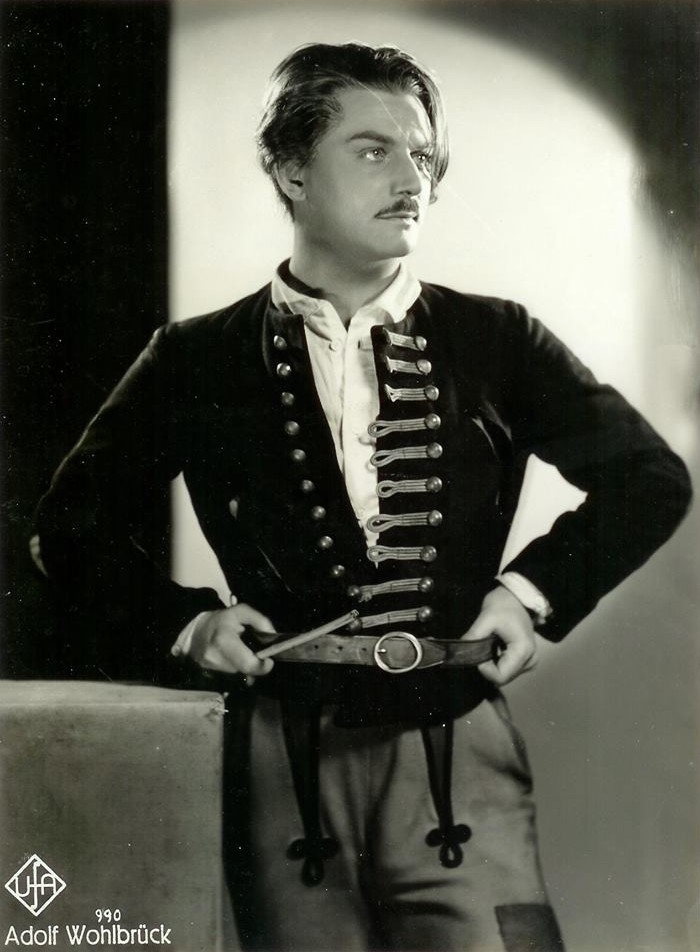
Adolf Wohlbrück in a 1935 UFA publicity shot for “Zigeunerbaron.” A “flotter Geist” indeed.
When Mr. Theis asked, they said they had come to see the idol of their youth, and they wanted to re-live their youthful crush. Their undiminished love for Wohlbrück made them overcome possible reservations about entering an LGBT institution; and according to Mr. Theis the female visitors loved the show, discussing Wohlbrück for hours after public guided tours. The exhibition showed letters and private documents, photos, program brochures and posters for films and stage productions. These objects came from Stiftung Deutsche Kinemathek Berlin, from the Filmmuseum und Theatermuseum Düsseldorf, from Deutsches Filmmuseum Frankfurt and the Theaterarchiv der Staatlichen Bühnen Dresden.
Sadly, no catalogue was released.
However, Adolf Wohlbrück is now a permanent feature at Schwules Museum, as part of the historic overview exhibition Change of Scenery (also curated by Wolfgang Theis). There you see him, topless, in a scene from the movie Der Kurier des Zaren, as an example of an openly gay star who managed to have a career in Nazi Germany, at least for a while. Right next to Wohlbrück is Gustaf Gründgens, who had such a career till 1945. By the way, Gründgens later adopted his life-partner, because same-sex marriage was not an option if you wanted to legally unite your lives. So some lived with their “secretaries,” others with their “sons,” and others with “room mates.” How times have changed, luckily!
[Special thanks to Lylah Clare and her insightful comments on Wohlbrück in the Adonises of the Silver Screen group.]

Ralph Benatzky told a funny story in his diaries about Charell and Dietrich: “Marlene Dietrich often comes across Charell, who takes no notice of her, at the hotel in Versailles. She is ostentatiously wearing trousers, has a pipe and bowler hat. When she finally confronts Erik about why he did not greet her, he says: ‘In our part of the country it is the custom that the man greets the lady first.’”
It’s possible that the Facebook group is closed precisely because they don’t want anybody talking about Wohlbrück’s sexual orientation (too upsetting to the homophobic fans), If you must be member to post, they can instantly eject any member who broaches the forbidden topic. There are Valentino groups where a mere whisper about bisexuality, even sourced to a biography, will get you the boot.
The Adolf Wohlbrück FB group has absolutely (!) no problems discussing his sexuality, I can assure you.
Thank you so much. I can impersonate his wonderful, moving delivery of (paraphrase) “Miss Page will not be able to appear… or indeed at any other performance” “the Red Shoes”. I don’t think he tried a Russian accent.
I can recommend James Downs “Anton Walbrook a Life of Masks and Mirrors”.
Anton’s vocal efforts are on YouTube. As a trained actor/singer myself I would say he does sing occasionally as opposed to speaking over the music. He seems to have had problems with his opinion of his nice actor’s baritone voice, Like Ivor Novello. Ivor does sing nicely for a few bars in the film “I stayed with you”. With Cosmo “Call me Madam” someone said another Cosmo spoke over the music as much as Walbrook. Anton is versatile with a great personality With accents could he do an English accent in German for Sir Hugo Latymer Coward)for instance? His last role. One performance had a to continue with the director reading in as Anton had a heart attack.
With the duet “Man Steigt Nach” Fall “die geschiedene Frau” what roles are Anton and & Lucie Mannheim playing? What do people think of “the Gipsy Baron” film? I think Anton just sings a bit of the pig-breeder’s song. Saffi is allowed the Gipsy Song. I’ve read the Jokai story. Was it re-written?